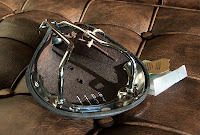Update July 2012: Please also read my recent review of the Model 1.
After my recent
Brooks mishap I decided to try something new.
Velo Orange, one of the brands that sells leather saddles made by Taiwanese company
Gyes, had a sale on two of their models, their "Model 3" being a copy of the Brooks B17 touring saddle, and "Model 1" a copy of the Brook Team Professional, which is somewhere in between a touring and a road racing saddle. It would be hard
not to compare the VO offerings with their Brooks counterparts, and since I have a good deal of experience with Brooks products, that's what I'll do.
 |
| Velo Orange Model 1 (left) and Model 3 (right) |
First, let's talk about cost. Shipping to Canada was 17 Dollars and unfortunately I also got hit with sales tax and processing fees (it's pretty unpredictable when you have to pay sales tax and when you don't). So the overall cost for both saddles was 60 + 65 + 17 + 25 USD, coming out to 83.50 per saddle. On Amazon.com, a real B17 currently
sells for 107 USD and a Team Pro
starts at 135 USD, both including shipping to the US. With some research it might be possible to get them for slightly less (e.g. buying from a European webshop), but the Velo Orange saddles are definitely still going to be cheaper, even at their regular price of 85 and 90 dollars.
 |
| "Aged" leather of the Model 3. Not the binding in the middle of the saddle |
On first view, the saddles look pretty similar to their Brooks inspiration, but there are a number of differences. For the Model 3, the most obvious one is the leather itself: whereas the regular Brooks features smooth leather, the VO saddle's surface resembles more that of the Brooks "Aged" models. The "aged" leather is supposed to break in more quickly--but consequently will also stretch and wear more rapidly. VO doesn't say anything in particular about the Model 3's leather and the leather still feels pretty stiff and hard. The Model 1, on the other hand, has a smooth surface that looks a little more dull than a real Brooks. But I'm suspecting that might change after the application of
Proofide and some polishing/riding.
 |
| Model 1. A little dull. |
From below, both saddles look quite different from a Brooks: instead of leather you see some kind of textile layered over the leather's surface. I guess this is for protecting the saddles from road spray, something that I don't have to care about because of my fenders. Another obvious difference between the Model 3 and a B17 is that the former is bound with two holes in the middle of the saddle. This prevents the sides of the saddle from flaring and it will also make the saddle a bit harder (depending on how tightly you bind it). Compared to a standard B17, Model 3's rivets are bigger. I'm not sure what they're made out of but it's not the copper of the more expensive Brooks saddles. Finally, in contrast to the Team Pro, Model 1 has bag loops, a feature that is pretty important to me and that made me buy a Swallow instead of the Team Pro for my road bike.
 |
| Here you can see the textile underlayer |
 |
| Underside of the Model 1 |
One less obvious difference are the saddle rails. I've complained about the sub-standard strength of Brooks rails (somewhere in the 6.6 to 6.7mm range) and fortunately the VO saddles feature wider rails. My calipers are out of battery at the moment, but it looks like the rails are at least 7mm wide. This will hopefully prevent the rails from breaking--but might also make the ride slightly harsher. Another frequent criticism of Brooks saddles is their limited fore-aft adjustability. Because Brooks saddles were developed in the age of slacker seat tube angles and haven't changed since then, some people have problems getting the saddle as far back as they would like to. I haven't measured the rails yet, but VO says theirs offer 10mm more space. (If you want even more range you should have a look at Selle AnAtomica saddles).
 |
| Model 1 next to a Brooks Swallow |
Another less obvious difference is weight: On my kitchen scale, the Model 1 came in at 541g (claimed weight 520g) and the Model 5 was 646g (vs 665g claimed). This makes a tie between Model 1 and a Team Pro (claimed weight 520g), but quite a difference between Model 3 and the claimed 520g of a B17.
I think this is all I can say for now, but updates will follow once the saddles are in use.
Update July 2012: Extensive review of the Model 1























